традиція святкування Дня батька
Де і коли з’явилася традиція святкування Дня батька? Хто її започаткував? Як підготуватись до цього свята? Пропоную добірку чудових текстів, з яких ви дізнаєтесь про історію виникнення цього свята в Сполучених Штатах. До вашої уваги цікаві статистичні дані з Бюро перепису населення про батьків, які виховують дітей самостійно без матерів. А ще ви дізнаєтесь про батьків і їх синів, яки стали американськими президентами. Ви знайдете інформацію про те, як американські діти готуються до цього дня, як вшановують своїх батьків, які подарунки дорослі отримують від дітей. Тут є ідеї підготовки до цього свята, наприклад, виготовлення листівок і незвичайних подарунків своїми руками. В цій розробці ви також знайдете список питань для дискусії про батьківство і теми до написання творів.И,звичайно, Father's Day Brainstorming and Writing
FATHER’S DAY
Ноздрачова Олена,
ЗОШ 11
м.Чернівці,2019

Father’s Day
Father’s Day History
Father’s Day has a very interesting history embedded in it. The thought for creating a day for children to honor their fathers began in Spokane, Washington. The idea of having a Father’s Day came to the mind of Sonora Smart while listening to a Mother’s Day sermon in 1909. After the death of her mother, she along with her siblings was raised by her father, William Jackson Smart. Sonora wanted to tell her father how special he was and what role he played in her life. She wanted to honor her father’s parental sacrifices that he made for his children. She wanted him to know what courageous, selfless and loving man he was. Since Sonora’s father was born in June, she chose to hold the first Father’s Day celebration in Spokane, Washington on the 19th of June in the year 1910.
The National Father’s Day Committee was formed in New York City in 1926. A Joint Resolution of Congress recognized the Father’s day in 1956 and in 1966; President Richard Nixon established a permanent national observance of Father’s Day to be held on the third Sunday of June. Thus, Father’s Day was born in memory and appreciation by a daughter who believed that her father and all other fathers should be honored with a special day just like mothers are honored on Mother’s Day. It is a day to celebrate fatherhood and male parenting. Though it is celebrated on a variety of dates throughout the world, the commonality among all celebrations is the gift-giving, special dinners for fathers and family-oriented activities.
Celebrate Father's Day
The United States is one of the few countries in the world that has an official day on which fathers are honored by their children. On the third Sunday in June, fathers all across the United States are given presents, treated to dinner or otherwise made to feel special.
The origin of Father's Day is not clear. Some say that it began with a church service in West Virginia in 1908. Others say the first Father's Day ceremony was held in Vancouver, Washington.
The president of the Chicago branch of the Lions' Club, Harry Meek, is said to have celebrated the first Father's Day with his organization in 1915; and the day that they chose was the third Sunday in June, the closest date to Meek's own birthday!
Regardless of when the first true Father's Day occurred, the strongest promoter of the holiday was Mrs. Bruce John Dodd of Spokane, Washington. Mrs. Dodd felt that she had an outstanding father. He was a veteran of the Civil War. His wife had died young, and he had raised six children without their mother.
In 1909, Mrs. Dodd approached her own minister and others in Spokane about having a church service dedicated to fathers on June 5, her father's birthday. That date was too soon for her minister to prepare the service, so he spoke a few weeks later on June 19th. From then on, the state of Washington celebrated the third Sunday in June as Father's Day. Children made special desserts, or visited their fathers if they lived apart.
States and organizations began lobbying Congress to declare an annual Father's Day. In 1916, President Woodrow Wilson approved of this idea, but it was not until 1924 when President Calvin Coolidge made it a national event to "establish more intimate relations between fathers and their children and to impress upon fathers the full measure of their obligations." Since then, fathers had been honored and recognized by their families throughout the country on the third Sunday in June.
When children can't visit their fathers or take them out to dinner, they send a greeting card. Traditionally, fathers prefer greeting cards that are not too sentimental. Most greeting cards are whimsical so fathers laugh when they open them. Some give heartfelt thanks for being there whenever the child needed Dad.
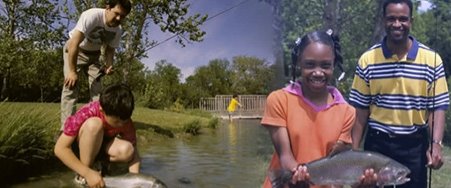 Father's Day Fun Facts
Father's Day Fun Facts
First Father’s Day
June 19, 1910, marked the first Father’s Day on record. Sonora Dodd from Washington State wanted to have a special day to show appreciation to her father William Smart, who was a Civil War veteran and a widower whose wife died during the childbirth of their sixth child. He raised his six children as a single father. The day was chosen in June, the month of Dodd’s father’s birthday.
Father's Day a National Celebration
Father’s Day was not recognized nationally on a large scale until 1966. President Lyndon Johnson designated the third Sunday of June to be Father’s Day.
However, not until 1972 did Father’s Day become an annual permanent holiday thanks to President Richard Nixon who signed Father’s Day as a public law.
Father's Day Statistics
Statistics from the US Census Bureau
There are 64.3 million fathers in the US.
Places to buy Dads a present: according to the US Census Bureau (2006), in America there are 9,003 men’s clothing stores, 14,012 hardware stores, and 23,270 sporting good stores.
In 2008, there were about 140,000 stay-at-home-dads raising 234,000 children.
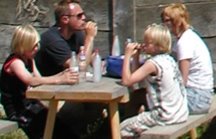 Statistics from A Child’s Day, 2006
Statistics from A Child’s Day, 2006
53% of children 6 or under ate breakfast with their dads.
71% of children 6 or under ate dinner with their dads.
6% of children 3 to 5 had a father who read to them in a one-week period.
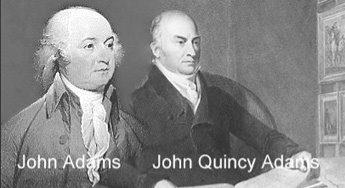 Father-Son Presidents
Father-Son Presidents
There has been two sets of father-son Presidents of the United States:
1. John Adams was the 2nd U.S. President (1797-1801). His son John Quincy Adams became the 6th US President (1825-1829).
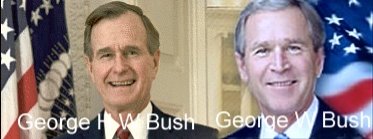 2. George Bush was the 41st U.S. President (1989-1993). His son George W. Bush became the 43rd U.S. President (2001-2009).
2. George Bush was the 41st U.S. President (1989-1993). His son George W. Bush became the 43rd U.S. President (2001-2009).
Father's Day Cards
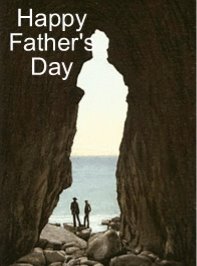 Hallmark recognizes Father’s Day as the 4th holiday for sending cards. 110 million cards are exchanged for Father’s Day. 50% of these cards are given to dads by sons and daughters. 20% are given by wives. And 30% are given by relatives and friends to anyone who is a father.
Hallmark recognizes Father’s Day as the 4th holiday for sending cards. 110 million cards are exchanged for Father’s Day. 50% of these cards are given to dads by sons and daughters. 20% are given by wives. And 30% are given by relatives and friends to anyone who is a father.
Most popular types of Father’s Day cards are “dad from daughter” cards.
Hallmark produces over 800 card designs for Father’s Day.
Father's Day Facts
Father's Day is one of the most awaited holidays in the world. It represents the day when we tell our dad how much he means to us and how lucky we are, to have him in our life. Though you don't need a special occasion to convey all this to him, telling it on Father's Day can make your daddy feel all the more special. While all of us know that Father's Day is a day dedicated to dads across the world, not many people are aware of the fact that it originated in the United States of America, that too owing to the efforts of Sonora Smart Dodd. Apart from this, there are many other interesting facts related to Father's Day, almost all of which have been listed in the lines below. Go through them and increase your knowledge about the special day!
Interesting Trivia On Father’s Day
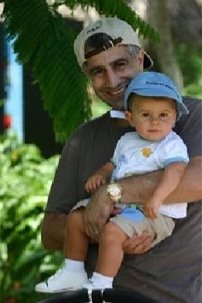
- In most of the countries around the world, like USA, UK, India, Canada, China, France, Greece, Japan and even Hong Kong, Father's Day is celebrated on the third Sunday of June.
- The person credited for inventing the concept of Father's Day is Mrs. Sonora Smart Dodd, an American whose father had raised his six children single-handedly.
- The first American president to support the concept of Father's day was President Calvin Coolidge, who did so in 1924.
- It was in the year 1966 that President Lyndon Johnson signed a presidential proclamation that resulted in the declaration of the third Sunday of June as Father's Day.
- The declaration of 3rd Sunday of June as Father's Day was signed as a law, and made permanent, by President Richard Nixon, in the year 1972.
- Father's Day originated in America. The first Father's Day celebration (unofficial) was held in Spokane, Washington, on 19th June 1910.
- One of the most common gifts associated with Father's Day comprises of a necktie, followed by flowers.
- Rose is the official flower for Father's Day. Wearing a red rose signifies a living father, while white one represents deceased father.
- It has been claimed by Hallmark, the renowned greeting card maker, that Father's Day makes up the fifth-largest card-sending holiday in the world.
- Greeting cards make up the number one gift item on the occasion of Father's Day.
- It has been estimated that more than one-third of the cards sold on Father's Day are funny in nature.
- A study came up with the fact that female shoppers spend approximately 50 percent more than men, while buying gifts for their dad.
- It is believed that the word "Dad" dates back to as early as the sixteenth century.
- In Australia, the first Sunday of September is observed as Father's Day, while Finnish people celebrate the festival on the second Sunday of November. In Thailand, 5th December is observed as Father's Day every year.
Father's Day Gift Ideas for Teachers
On the third Sunday in June, Americans everywhere celebrate the contribution that fathers make to society on Father's Day. Although the summer vacation is nearing, teachers can encourage students to make a present for Father's Day by setting aside craft time for the occasion. Whether your students are young or old, you can find a Father's Day craft that suits their ability levels.
1. Cards
• Cards are an essential gift for Father's Day. Students can simply fold a piece of construction paper, draw a picture and write a message inside. Alternatively, you can embellish the card with other craft items, such as feathers, fabric, glitter and paint.
2. Picture Frames
• Students can make a picture frame they can use to highlight a picture of their father. Start with a blank wooden craft frame and have students paint it or glue items onto it. Or make a frame from wooden twigs that students collect on a nature walk.
3. Paper Tie
• Very young students may not yet be able to make an intricate craft, but they still want to honor their fathers. They can do this with a paper tie. Have students cut out a paper tie from white construction paper, then use stamps and paint to decorate it. If your students are not yet old enough to use scissors, you can cut the ties out for them.
4. Barbeque Apron
• Start with a blank apron and have students use fabric paint to create an apron that's special for their fathers. You can also print messages such as "World's Greatest Dad" onto iron-on transfer paper and help the students iron the image onto the apron.
5. Letter
• Have students write a letter to their fathers saying how important fathers are. If students are young and need a bit of help with this, you can print out a worksheet that says "Top 10 Reasons My Dad Is Great" with blank lines. Students can put a reason on each line.
6. Paperweight
• Students can make a paperweight that Dad can take to the office. One way to do this is to paint a rock with a special image or message. Or let them craft something out of clay and fire it so that it becomes hard.
Father's Day Brainstorming and Writing
Grade Levels: 4 - 6
Objectives
Students will practice their brainstorming and writing skills.
- Students will discuss what fatherhood means.
Materials
- Pens, paper
- Fathers as Caretakers handout
Procedures
- First, keep in mind that not all of your students may have fathers in their lives, due to death or separation. These students could participate in the projects by modifying the gifts for other important adults in their lives.
-
Share the following basic information about the history of Father's Day with your students:
- The founding of Father's Day is associated with Mrs. John B. Dodd of Washington State. Mrs. Dodd's mother died in childbirth, leaving her father, William Smart, to raise six children. As an adult Mrs. Dodd came to realize the difficulties her father must have faced as both a working farmer and single father. Thanks to her efforts the first Father's Day was celebrated in Spokane, WA, on June 19, 1910. The third Sunday of June was not designated as Father's Day until 1966 when President Lyndon Johnson signed a presidential proclamation declaring the holiday.
- Brainstorm with your class about the meaning of fatherhood, from general to more specific ideas about what being a father means.
- Talk about how fathers are represented in the media, from Mr. Cleaver to Tim Allen to Homer Simpson.
- How have images of fatherhood changed over time?
- What kind of a father do they think Barack Obama is? Joe Biden?
- Now, you can brainstorm with your class about the meaning of "father figures." Many people have been influenced by men who act as father figures. We look to the powerful, kind men around us to help us understand what being a man means, and how men should act.
- What does fatherhood mean metaphorically? For example, consider a term used often in history classes – the "Founding Fathers" – which refers to the men who wrote the Constitution. They are fathers of what, and of whom?
- Discuss statistics about fathers as caretakers. Why, for example, are men in New England more likely to care for children than men in the South?
- Distribute the Fathers as Caretakers handout. Read this with your students.
Fathers as Caretakers -- Facts and Figures
In 1993, about one in four fathers took care of their preschoolers during the time mothers were working. In fact, fathers provided care for their children during more of the mother's working hours than did any other single care provider.
(The increase in care by fathers between 1988 and 1991 may have been a response to the economic recession that occurred during the same period – the recession began in July 1990 and reached its lowest point in March 1991. Increases in the proportions of people who were not employed and working at part-time jobs may have meant that more fathers were available to serve as childcare providers. The increase in care by fathers may have also reflected the desire of parents to cut down on childcare costs by switching to more parental supervision of their children whenever possible. That the decline in care by fathers between 1991 and 1993 occurred at the same time as the economy was expanding also supports this notion.)
Other findings about married fathers with preschoolers whose mothers were employed in 1993 include:
- Care by fathers is most common in poor families. Childcare costs constitute an especially large proportion of a poor family's budget, so it comes as no surprise that fathers in poor families are more likely to take care of their children than fathers in nonpoor families – 43 percent compared with 24 percent in 1993, for example.
- Fathers in service occupations are more likely than fathers in other occupations to provide care for their preschoolers while their mothers are at work. Fathers who work in service occupations such as maintenance, police, fire-fighting, and security positions are about twice as likely as fathers in any other occupation to be taking care of the preschoolers while the mothers are working. For example, in 1993, 42 percent of fathers in service occupations cared for their preschool-age children compared with about 20 percent of fathers who were in managerial/professional or technical/sales occupations. Both patterns may be due to the fact that fathers in service occupations are more likely to work nontraditional schedules than other fathers and therefore may be more likely to be available for care.
- Care by fathers is most common in the Northeast and least common in the South. Care by fathers is more common in some areas of the country than in others. In 1993, fathers in the Northeast were the most likely to be taking care of their children and to be providing primary care, while those in the South were the least likely to be doing so. About 33 percent of fathers in the Northeast provided care for their preschoolers during the mothers' working hours, compared with 27 percent of fathers in the Midwest and West and only 18 percent in the South. Care by fathers was especially prevalent in New England, where four out of ten fathers cared for their children in 1993. Geographical differences in the frequency of fathers caring for their children may relate to regional variations in employment rates, and in costs of childcare and amounts of family income available to purchase alternative childcare services. Childcare costs are indeed more expensive in the Northeast than in either the Midwest or the South. And in 1993, fathers were more likely to be unemployed in the Northeast than in the Midwest or the South. It could also be that childcare facilities may be farther away in some areas than in others; this might cause more people to choose neighbors and relatives (including fathers) over childcare facilities that may be less accessible.
You are ready to have your students write an essay on the meaning of fatherhood. Here are a few essay topics:
- My father and me: Describe the positive aspects of your relationship with your father or your father figure. You may want to use personal anecdotes.
- More than just one day: How can we support and love our fathers every day?
- If you were to become a father, what kind of father would you want to be? If you were to become a mother, what kind of father would you want your children to have?


про публікацію авторської розробки
Додати розробку
